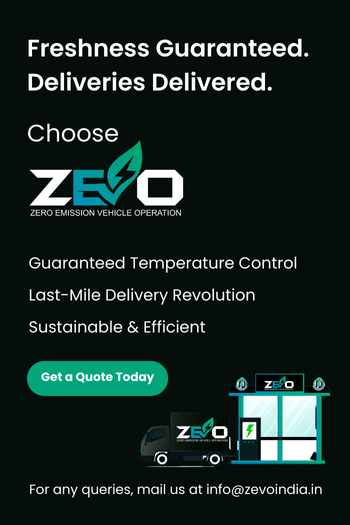The ROI of Refrigerated Last-Mile Delivery

Akshay Sharma
CEO's Office @ZEVO
The last mile of the delivery journey is critical for perishable goods.
Ensuring products reach the end consumer in optimal condition is paramount for businesses in the food, pharmaceutical, and other temperature-sensitive industries.
Refrigerated last-mile delivery offers a solution, but is it worth the investment?
Let’s dive into the potential return on investment (ROI) of this specialized service.
Understanding the Costs in India
Refrigerated last-mile delivery can be more expensive than standard delivery in India, but it can also help ensure that your temperature-sensitive products reach your customers in good condition. Here’s a breakdown of the cost factors to consider:
Refrigerated last-mile delivery in India can incur 20-30% higher costs compared to standard delivery. This is primarily driven by the following factors:
- Specialized vehicle costs (purchase or lease)
- Higher fuel consumption due to refrigeration
- Additional maintenance and potential repair costs
Additional Considerations
Proper maintenance of refrigeration units and specialized driver training are crucial for ensuring safe delivery of temperature-sensitive goods.
As you can see, the biggest cost factors are the specialized vehicles and the fuel consumption. However, the cost of spoilage and returns can be much higher if you don’t use refrigerated transportation for your temperature-sensitive products.
Potential Revenue Increases
The potential for revenue growth in refrigerated last-mile delivery is significant, driven by various market trends and consumer demands. The global last-mile delivery market, valued at approximately $132.71 billion in 2022, is projected to grow at a CAGR of 8.8%, reaching about $258.68 billion by 2030.
This growth is fueled by the rising consumer expectation for rapid delivery services, particularly for temperature-sensitive products.
The refrigerated transport market, essential for maintaining the quality of perishable goods during last-mile delivery, was valued at $113.4 billion in 2022 and is expected to grow at a CAGR of 7.2%, potentially reaching $160.7 billion by 2027. This indicates a robust demand for temperature-controlled logistics, which is crucial for sectors like food and pharmaceuticals.
Refrigerated last-mile delivery offers several avenues for revenue growth:
- Expanded Market Reach: Access to new markets for temperature-sensitive products can significantly increase customer base and revenue potential.
- Improved Customer Satisfaction: Delivering products in pristine condition enhances customer loyalty, leading to repeat business and positive word-of-mouth, thereby increasing revenue.
- Premium Pricing: Charging higher prices for guaranteed product quality is feasible, especially in sectors like food and pharmaceuticals where quality is paramount.
- Reduced Product Waste: Minimizing spoilage and returns directly impacts profitability by reducing costs associated with waste.
Calculating ROI
Determining the ROI of refrigerated last-mile delivery involves a careful analysis of costs and potential benefits. Key factors to consider include:
- Total Investment: Sum of initial and ongoing costs, including vehicle purchase or lease, equipment maintenance, fuel, driver training, and technology.
- Projected Revenue Increase: Estimated additional income from expanded market reach, premium pricing, and reduced product waste.
- Cost Savings: Potential savings from reduced product spoilage and returns.
- Timeframe: Expected period to recoup the initial investment.
A basic ROI calculation can be determined using the following formula:
ROI = (Total Revenue – Total Costs) / Total Investment
However, a more comprehensive analysis may require advanced financial modeling to accurately assess the long-term profitability of refrigerated last-mile delivery.
Case Studies
To illustrate the potential benefits of refrigerated last-mile delivery, it’s helpful to examine successful case studies. While specific data may vary across industries and regions, these examples provide insights into the potential ROI:
- Online Grocery Retailer: A major online grocery retailer implemented refrigerated last-mile delivery for perishable items. By investing in a fleet of refrigerated vehicles and advanced temperature monitoring systems, they experienced a 20% increase in customer satisfaction and a 15% reduction in product returns within the first year. This led to a significant boost in revenue and improved brand reputation.
- Pharmaceutical Distributor: A pharmaceutical distributor adopted refrigerated last-mile delivery to ensure the integrity of temperature-sensitive medications. By implementing stringent quality control measures and investing in driver training, they achieved a 99.9% on-time delivery rate and reduced product wastage by 30%. This resulted in increased customer loyalty and cost savings.
It’s essential to tailor case studies to specific industries and target audiences to effectively demonstrate the ROI potential of refrigerated last-mile delivery.
Conclusion
While refrigerated last-mile delivery involves additional costs, the potential for increased revenue, improved customer satisfaction, and reduced product waste makes it a compelling investment for businesses handling perishable goods. By carefully analyzing costs, potential benefits, and calculating ROI, companies can make informed decisions about adopting this specialized service.
Factors such as market trends, consumer behavior, and technological advancements will continue to shape the landscape of refrigerated last-mile delivery. Businesses that stay ahead of these trends and invest in efficient and reliable solutions are likely to reap the rewards of this growing market.

Share this Article
Subscribe to our newsletter
Be the first to receive exclusive offers and the latest news on our products and services directly in your inbox.
